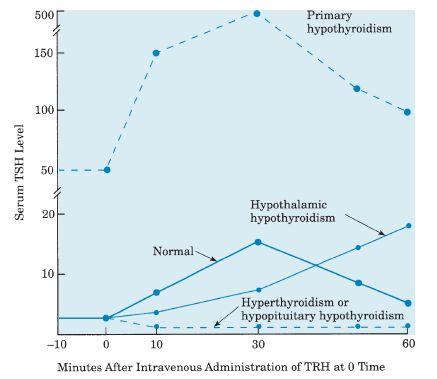Wallach's Interpretation of Diagnostic Tests: Pathways to Arriving at a Clinical Diagnosis (1246 page)
Authors: Mary A. Williamson Mt(ascp) Phd,L. Michael Snyder Md

BOOK: Wallach's Interpretation of Diagnostic Tests: Pathways to Arriving at a Clinical Diagnosis
11.28Mb size Format: txt, pdf, ePub
TRH is a hormone produced in the hypothalamus; it can stimulate the release of TSH from the pituitary gland. TSH then further stimulates the production and the release of T
3
and T
4
from the thyroid gland. Therefore, the TRH stimulation test can evaluate the thyroid function status. However, TRH also stimulate the release of growth hormone (GH) as well as prolactin. Three blood specimens are collected for serum TSH testing: one immediately prior to TRH injection, and one 15 minutes and one 30 minutes after TRH injection. TRH is administrated IV (200–500 μg). Pharmacy consultation for TRH dosage is recommended (see Fig. 16.4).

Figure 16–4
Sample curves of serum thyroid-stimulating hormone (TSH) response to administration of thyrotropin-releasing hormone (TRH) in various conditions.
Use
Rarely used clinically for diagnosis of the thyroid diseases. Measurements of serum TSH and T
3
and T
4
levels are informative in evaluating thyroid function in most clinical situations. However, when the diagnosis is still unclear, the TRH stimulation test can be of help.
May be particularly useful in T
3
toxicosis in which the other test results are normal or in patients clinically suspicious for hyperthyroidism with border-line serum T
3
levels. TRH stimulation test is superior to the T
3
suppression test of RAIU. Abnormal TSH response to TRH administration does not definitely establish the diagnosis of hyperthyroidism (because autonomous production of normal or slightly increased amounts of thyroid hormones causes pituitary suppression). TRH test may remain abnormal even after successful therapy of Graves disease.
Helps differentiate two forms of thyrotropin-induced hyperthyroidism (whether or not due to tumor).
May help differentiate hypothalamic from pituitary hypothyroidism.
Interpretation
Normally, a significant rise in serum TSH occurs from a basal level of 2–3 μU/mL, and this then returns to normal by 120 minutes. Response is usually greater in women than in men. A blunted response indicates hyperthyroidism but may occur in other conditions (e.g., uremia, Cushing syndrome, starvation, elevated levels of glucocorticoids, depression, some elderly patients). Largely replaced by sensitive TSH assays.
Hyperthyroidism: ruled out by a normal increase of >2–3 μU/mL after TRH administration
Primary hypothyroidism: an exaggerated prolonged rise of an already increased TSH level
Secondary (pituitary) hypothyroidism: no rise in the decreased TSH level
Other books
Taft by Ann Patchett
My Sister's Prayer by Mindy Starns Clark
Fighting to Survive (Guarded Hearts Book 3) by Noelle, Alexis
A Prayer for Dead Kings and Other Tales by Scott Fitzgerald Gray
El mal by David Lozano
Leavin' Trunk Blues by Atkins, Ace
Cricket XXXX Cricket by Frances Edmonds
Talk of the Town by Sherrill Bodine
Waiting For Rachel: A Christian Romance (Those Karlsson Boys) by Jordan, Kimberly Rae
